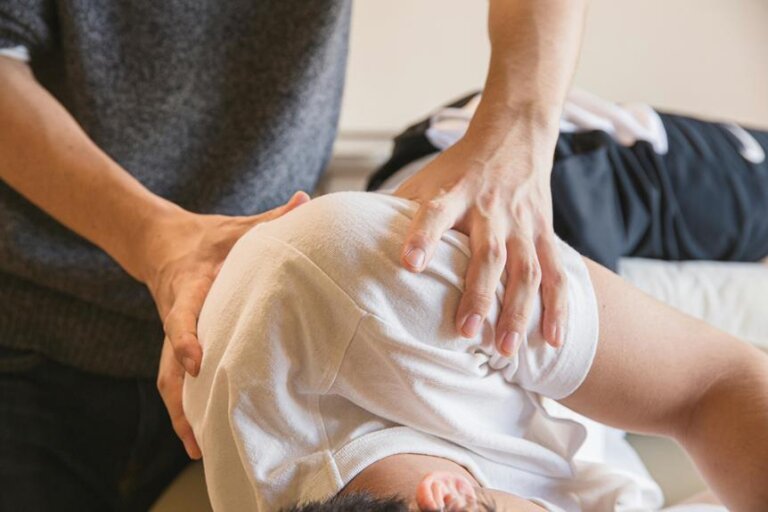Debunking Common Myths About Back Pain
Discover the deceptive delusions surrounding back pain that may have you puzzled and perplexed.
But what if some of the beliefs you hold dear are actually misconceptions?
Unravel the truth behind these prevalent myths that could be affecting your understanding of back pain and its management.
Myth: Back Pain Is Always Caused by Injury
Contrary to popular belief, back pain isn't always caused by an injury. While it's true that injuries like muscle strains or herniated discs can lead to back pain, there are numerous other factors that can contribute to or even be the primary cause of your discomfort. Poor posture, muscle imbalances, obesity, and even stress can all play a significant role in the development of back pain.
When it comes to addressing back pain that isn't directly related to an injury, it's essential to consider these alternative causes. Making simple lifestyle changes such as improving your posture, incorporating regular exercise to strengthen your core muscles, maintaining a healthy weight, and practicing stress-reducing techniques like yoga or meditation can all help alleviate non-injury-related back pain.
Myth: Rest Is the Best Treatment
Resting may not always be the best treatment for back pain, despite common belief. While it's natural to think that staying off your feet will help alleviate discomfort, prolonged rest can actually lead to muscle stiffness and weakened support for your spine. In fact, in many cases, staying active within your limits can be more beneficial for managing back pain.
When you rest for extended periods, your muscles can weaken, leading to further issues down the line. Movement, on the other hand, helps improve blood flow to the affected area, promoting healing and reducing inflammation. Gentle activities like walking or stretching can often provide more relief than staying immobile.
It's essential to strike a balance between rest and activity when dealing with back pain. Listen to your body and avoid overexertion, but also don't be afraid to incorporate gentle movements into your routine. Remember, every individual is different, so what works for one person may not work for another.
Myth: Exercise Makes Back Pain Worse
Exercise can actually help alleviate back pain rather than make it worse. It may seem counterintuitive, but engaging in appropriate physical activity can strengthen the muscles that support your spine, improve flexibility, and promote better posture. When done correctly, exercise can reduce the risk of future back issues by keeping your spine strong and stable. Activities like walking, swimming, or yoga can be particularly beneficial for back pain relief.
Certain exercises, such as low-impact aerobics or core-strengthening routines, can target the muscles in your back and abdomen, providing support to your spine and reducing discomfort. Additionally, staying active can help you maintain a healthy weight, which is crucial for minimizing strain on your back.
However, it's essential to consult with a healthcare professional or a physical therapist to determine the most suitable exercises for your specific condition. They can provide guidance on proper techniques and recommend personalized routines that will address your back pain effectively. Remember, the key is to start slowly and gradually increase the intensity to avoid exacerbating your symptoms.
Myth: Only Older Adults Experience Back Pain
Don't assume that back pain exclusively affects older adults; this common misconception overlooks the fact that individuals of all ages can experience back pain. Back pain isn't limited to the elderly; it can strike anyone, regardless of age. In fact, young adults, teenagers, and even children can suffer from back pain due to various reasons such as poor posture, sedentary lifestyles, or sports injuries.
Younger individuals often dismiss their back pain as a temporary discomfort, attributing it to their hectic schedules or physical activities. However, ignoring back pain, regardless of age, can lead to chronic issues if not addressed promptly. It's essential to pay attention to any signs of back pain, regardless of your age, and seek appropriate medical advice to prevent further complications.
Myth: Surgery Is the Only Solution
Contrary to popular belief, surgery isn't always the sole solution for addressing back pain. While surgery can be a viable option in some cases, it's essential to explore non-invasive treatments before considering surgical intervention. Many individuals find relief from back pain through alternative methods such as physical therapy, exercise, medication, and lifestyle modifications. These approaches can often strengthen the muscles supporting the spine, improve flexibility, and alleviate pain without the need for surgery.
It's important to consult with healthcare professionals like physical therapists, chiropractors, or pain management specialists to develop a comprehensive treatment plan tailored to your specific condition. They can provide guidance on exercises to strengthen your back, ergonomic adjustments to your workspace, and other non-surgical interventions that may effectively manage your back pain. By exploring these non-invasive options first, you may be able to avoid the risks and long recovery times associated with back surgery while still finding relief for your pain.
Myth: Poor Posture Is the Sole Culprit
You might think that slouching is the root cause of your back pain, but it's not that simple. While poor posture can contribute to discomfort, there are usually multiple factors at play.
Understanding the complexity of back pain can help you address the issue more effectively.
Posture Isn't Everything
While poor posture can contribute to back pain, it's important to recognize that it isn't the sole cause. Posture plays a role in back health, but factors like muscle strength, flexibility, and overall physical condition also influence your back's well-being.
Simply correcting your posture may not completely alleviate back pain if other underlying issues are present. Additionally, activities like heavy lifting, sudden movements, or prolonged sitting can strain your back regardless of your posture.
Therefore, focusing solely on posture may not address the root cause of your back pain. It's essential to consider a holistic approach to back health by incorporating proper posture along with other lifestyle changes and exercises to effectively manage and prevent back pain.
Multiple Factors at Play
Poor posture is often mistakenly identified as the sole cause of back pain, overlooking the various other contributing factors that play a significant role in back health. While posture indeed influences back health, factors like muscle strength, flexibility, body weight, and even emotional stress can also impact your back.
Poor muscle strength, particularly in the core and back muscles, can lead to instability and strain on the spine. Lack of flexibility can limit your range of motion and increase the risk of injury. Additionally, being overweight puts extra stress on your spine, exacerbating back pain. Emotional stress can also manifest physically, causing muscle tension and discomfort in the back.
Understanding and addressing these multiple factors is crucial for maintaining a healthy back.
Frequently Asked Questions
Can Emotional Stress or Psychological Factors Contribute to Back Pain?
Yes, emotional stress or psychological factors can contribute to back pain. When you're stressed, your muscles tense up, leading to discomfort. It's essential to address both physical and emotional well-being for comprehensive back pain management.
Is It Possible for Back Pain to Be a Sign of a More Serious Underlying Health Condition?
Sometimes a twinge could signal a deeper issue. Listen closely to your body. Seek medical advice if back pain persists or is accompanied by concerning symptoms. Remember, prevention is better than cure.
Are There Specific Exercises or Stretches That Can Help Alleviate Back Pain?
To alleviate back pain, try exercises like gentle stretches, yoga, or walking. Strengthening core muscles can also help. Remember to consult a healthcare provider before starting any new exercise routine to ensure safety.
How Does Nutrition and Diet Play a Role in Managing Back Pain?
Nourish your body with nutrient-rich foods to nurture your spine. Incorporate inflammation-fighting foods like berries, fatty fish, and leafy greens. Stay hydrated to support spinal discs. Remember, a balanced diet can aid in managing back pain.
Are There Alternative Treatments or Therapies That Have Been Proven Effective in Relieving Back Pain?
There are alternative treatments like acupuncture, yoga, and chiropractic care that have shown effectiveness in relieving back pain. They can complement traditional methods and provide relief for many individuals seeking non-pharmacological options for pain management.
Conclusion
So, now you know that back pain isn't always caused by injury, rest may not be the best treatment, and exercise can actually help alleviate pain.
While some may argue that surgery is the only solution, it's important to explore other options like physical therapy and lifestyle changes first.
Remember, maintaining good posture and staying active can help prevent and manage back pain effectively.
Don't let common myths stop you from finding relief.






